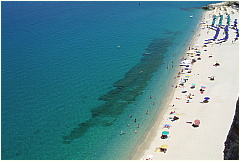






Palau offers you the world's most beautiful tropical paradise. Famous for its diving, Palau is rated as one of the world's best diving destinations by scuba aficionados. And why not...Palau has unspoiled reefs, caves, and walls with the most amazing array of marine life you can ever imagine.
Palau beckons to you with some of the world's most awesome natural wonders. Imagine the whitest beaches you will ever see, gardens of coral just beneath the clearest waters, lakes filled to the brim with "sting less" jellyfish. Forests, waterfalls and caves that have never been ravaged by man, and hundreds of islands of the purest beauty abound all along our pristine archipelago.
Location and Geographic Description
7° 30' North Latitude, 133° 30' East Longitude
Offical Languages
English and Palauan
Time Zone
When it's Noon Monday in Palau, it is:
Manila 11:00 A.M. Monday
Tokyo 12:00 P.M. Monday
Sydney 1:00 P.M. Monday
Honolulu 5:00 P.M. Sunday
Los Angeles 7:00 P.M. Sunday
Climate
Palau enjoys a pleasantly warm climate all year round with an annual mean temperature of 82° degrees F. (27° C.). Rainfall can occur throughout the year, and the annual average is 150 inches. The average relative humidity is 82%, and although rain falls more frequently between July and October, there is still much sunshine. Typhoons are rare as Palau is located outside the typhoon zone.
Currency & Credit Cards :
The official currency of the Republic is the U.S. Dollar. Visa, JCB, Master Card, and American Express cards are widely accepted at stores and visitor facilities. There are FDIC insured banks and major hotels with limited foreign currency exchange. In addition, Palau has money transfers such as Western Union or through Bank Institution.
Customs, Immigration & Health Requirements
One (1) bottle of liquor and one (1) carton of cigarettes can be brought into Palau duty-free. Importation of controlled substances and weapons is strictly prohibited. Travelers must have valid Passport. All visitors must have return travel arrangements or approval by the Chief of Immigration for an extended stay. The fee is $100.00 (U.S.). Cholera and Yellow Fever immunizations are required for those arriving from infected areas.
Getting There
Many visitors to Palau arrive on Continental Airlines by way of daily flights from Guam--gateway to Micronesian. There are daily connections to Guam from Tokyo, USA, and other metropolitan centers around the world. Continental Airlines provide daily flights from Guam to Palau and twice a week from Manila, Philippines.
In addition, there are scheduled chartered ariline services and they are Asiana Airline from Incheon, South Korea, China Airline from Taipei, Taiwan-ROC, and Japan Airlines from Tokyo, Nagoya and Osaka, Japan to Palau.
From the western seaboard of the United States, you can hop to Hawaii, skip to Guam, then jump to Palau. For a scenic island route, you can do an island hop across Micronesia to Palau. Through Asia, there are twice weekly charter services between Taipei, Taiwan and Palau and additional flights are also available during peak seasons. From Europe,visitors can fly via Emerates direct to Manila, Philippines and onwards with Continental Airlines to Palau--this is possible without overnight stay in Manila.
Beaches and Diving
Palau is one of the most extraordinary diving spots on this planet. Far to the southwest of Micronesia the Republic of Belau (the traditional name) consists of an archipelago of 343 islands, spread north to south over 100 miles form the atoll of Kayangel to the island of Angaur plus five tiny islands, known as the southwest islands.
Palau's profuse, unspoiled reefs offer a wealth of marine life, coral formations and wrecks. Dives begin in knee deep water and plunge straight down to depths of 1000 feet and more.
Blue holes, huge caverns and an immense variety of rare and exotic marine species are easily accessible in clear water with visibility exceeding 200 feet. Vast numbers, not found anywhere else in the world, of large pelagic predators, sharks, turtles, dolphins and many species of migratory fish gather here at a unique crossroads of three of the world's major ocean currents. Land locked marine lakes, accessible from the sea through tunnels beneath the island's steep shorelines, are home to rare jelly fish, anemones and soft corals.
Palau's famed "Rock Islands" are a collection of rounded, foliage-covered isles which seem to float above the surface of the water. A boat trip through them will reveal a number of magnificent white sand beach hideaways perfect for a secluded picnic or adventurous overnight stay. Below the water's surface, divers and snorkelers are treated to a diverse technicolor paradise of fabulous drop-offs, blue holes , breathtaking reefs, crystal caves and World War II wrecks.












.jpg)






.jpg)














